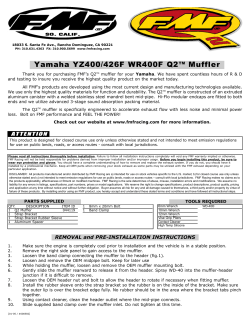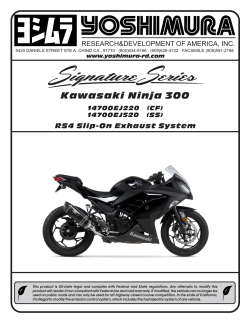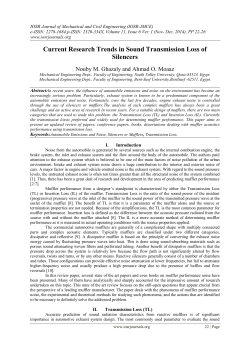
f-Yamaha TTR250 99-04 Q (000523)0406.qxp
18033 S. Santa Fe Ave. Rancho Dominguez, CA 90221-5514 PH: 310-631-4363 FX: 310-900-5699 www.fmfracing.com [03-06 / #000523] Yamaha TTR250 TheQ TM S/A Installation Thank you for purchasing an FMF QTM muffler for your Yamaha TTR250. We have spent countless hours of R & D and testing to insure you receive the highest quality product on the market today. All FMF's products are developed using the most current design and manufacturing technologies available. We use only the highest quality materials for function and durability. Depending on the application, The QTM muffler is constructed of an extruded aluminum canister with a welded stainless steel mandrel bent midpipe. Tru-Flo modular endcaps are fitted to both ends and we utilize advanced multi stage packing material. The QTM muffler is specifically engineered to accelerate exhaust flow with less mass, less noise and minimal power loss. Bolt on FMF performance and FEEL THE POWER! Check out our website at www.fmfracing.com for more information. Please read all instructions thoroughly before installation. Failure to follow all installation instructions completely will void any FMF warranty implied or otherwise. FMF Racing will not be held responsible for problems derived from improper installation and/or improper usage. Before you begin installing this product, be sure you are wearing eye protection and gloves. You should have a complete understanding of how to remove and replace your stock exhaust otherwise have your new FMF muffler installed by a professional mechanic. Keep all stock hardware when removing your exhaust, as some components may be necessary to install the FMF exhaust depending on your application. PA RT S S U P P LI E D (1) Q Muffler (1) Strap Bracket (1) 8mm x 20mm Bolt (1) Aluminum Spacer (1) Band Clamp 1. 2. 3. 4. 5. 6. TOOLS REQUIRED 044111 940017 920192 920098 940082 10mm Wrench 6mm Allen Wrench Phillips Screwdriver Vise Grip Pliers Contact Cleaner WD-40® High Temp Silicone REMOVAL Make sure the engine is completely cool prior to installation and the vehicle is in a stable position prior to installation. Remove the right side panel to gain access to the muffler. Loosen the band clamp at the midpipe/header junction. Remove the bolt that attaches the midpipe to the subframe of the bike. Keep for later use. While supporting the muffler, loosen and remove the rear upper muffler bolt. Gently slide the muffler rearward to release it from the header. Use WD-40 in the midpipe/header junction to help ease removal. P R E - I N S TA L L AT I O N 7. 8. Using contact cleaner, clean the slip fit section of the header where the midpipe connects. Allow to dry then lightly coat with a bead of high temp silicone for an improved seal. Slide the supplied band clamp onto the the muffler inlet. Do not tighten at this time. I N S TA L L AT I O N 8. 9. 10. 11. 12. 13. Slide the FMF muffler onto the header. The FMF logos should be at the 3 & 9 o’clock position when looking from the rear. Wipe away any excess silicone. Install the stock bolt through the subframe and thread into the midpipe. Do not fully tighten at this time. Carefully slide the strap bracket over the muffler and position it to the rear upper mounting point. Make sure the “inside” sticker on the bracket is towards the subframe. Using vise grip pliers, pinch the strap bracket tabs together and install the supplied 8mm x 20mm bolt to attach the strap bracket to the frame with the supplied spacer between the subframe and the strap bracket. Make sure the header and muffler are in neutral positions and not binding. Slowly tighten all mounting fasteners and clamps to manufacturer’s specifications, starting fat the midpipe and working your way to the back. Inspect the complete exhaust to make sure there is no contact with the frame, shock spring, engine, body panels or any cables, hoses or wiring. The exhaust system should only be in contact with the exhaust port and mounting points. Confirm all controls operate in accordance with the manufacturer’s specifications. POST-INSTALL ATION 14. 15. 16. 17. We recommend using high temp silicone for an improved seal. Please follow instructions for the silicone and allow sufficient time to dry before starting the engine. Before operating your vehicle, we recommend either stock jetting or installing our Power-Up Jet kit for optimum performance. Our jetting recommendations are to be used as a guide only and were developed based on operation at sea-level at 70 degree ambient air temperature. There are too many variables outside our control to give you exact specifications. If you’re not capable of tuning a carburetor yourself, please find a mechanic in your area. Refer to our website for additional jetting information. Start the engine and bring it up to operating temperature. Check for exhaust leaks. Let engine cool completely and re-torque all mounting hardware to the manufacturer’s specifications. MAINTENANCE To clean your FMF muffler, allow to cool. Do not spray water onto a hot exhaust. Dry completely to prevent streaking. Mild soap and water are recommended on the muffler canister to reduce streaking and uneven discoloration. We recommend repacking your FMF muffler after every 20-30 hours of normal use when properly jetted. This will maintain peak performance and keep that race tone. Water will ruin the packing. Cover the exhaust outlet when washing your machine. Repack your muffler if water gets inside and saturates the packing material. FMF offers a variety of packing materials to choose from. If your FMF muffler has a spark arrestor screen, we recommend cleaning it gently using a wire brush after every 30 hours of use. To repack the muffler, remove the allen screws from the front of the muffler. There is no need to remove the rear endcap. Gently slide the midpipe and core out the front of the muffler canister. You may need to use a rubber or plastic mallet to lightly tap it out. Be careful not to damage the muffler. Unwrap the packing from the core and discard. Wrap the core with new packing and secure with two strips of 1/2” masking tape around the packing 2” from each end. Do not pack too tightly as this will hinder performance and increase the sound level. Before re-installing the inner core assembly, apply a thin layer of high temp silicone on the front endcap where it makes contact with the canister. Slide inner core assembly into canister making sure the perforated core fully seats in the rear endcap. Wipe off any excess silicone. Re-install the allen screws until snug or tighten 1/4 turn after the screw makes contact with the canister. Allow silicone to dry before starting engine. DISCLAIMER: All products manufactured and/or distributed by FMF Racing are a) intended for use on stock vehicles specific to the U.S. market; b) for closed course use only unless otherwise stated and c) not intended to meet emission regulations for use on public lands, roads or access routes – consult with local jurisdictions. FMF Racing makes no claims as to the products applicability, effectiveness or fitment on modified machines. FMF Racing is the sole determines of abuse, misuse, installation errors and modifications. We assume no liability for any errors in listings, specifications, part numbers, prices or model applications. We reserve the right to change specifications, product descriptions, product quality, pricing and application at any time without notice and without further obligation. Buyer assumes all risk for any and all damage caused to themselves, a third party and/or property by virtue of failure of these products. By installing and/or using an FMF product, you hereby accept and understand these stated terms and conditions and have followed all instructional steps.
© Copyright 2024















